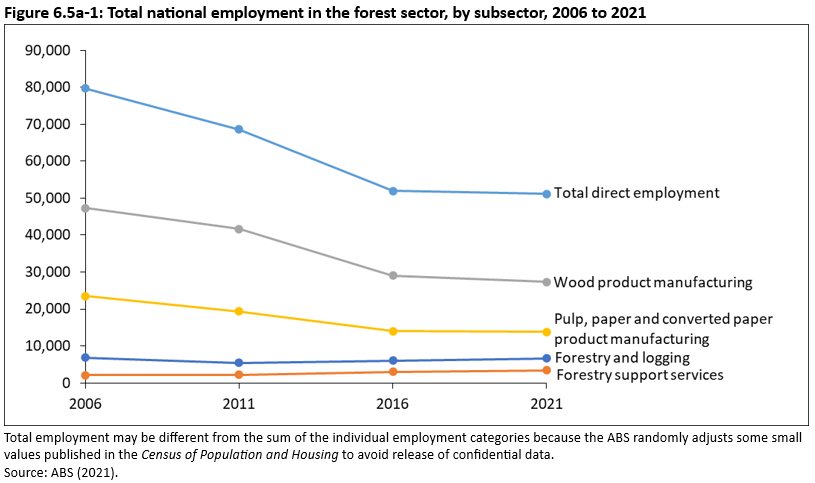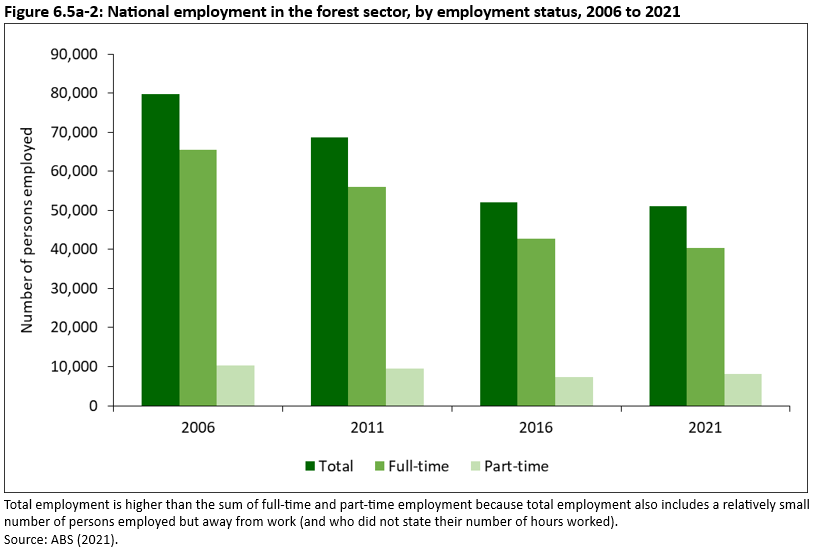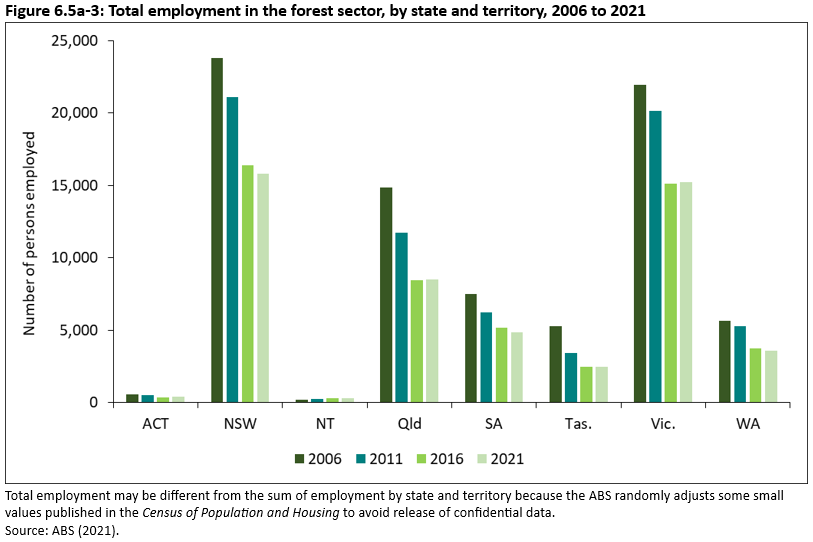This indicator measures the level of direct and indirect employment in the forest sector. Employment is an important measure of the contribution of forests to viable communities and the national economy.
This is the Key information for Indicator 6.5a, published July 2024.
- Total national direct employment in the forest sector was 51,120 people in 2021, a slight decrease from 51,983 people in 2016.
- Of the total national direct employment in the forest sector 79% were full-time, 16% part-time and the balance were away from work at reporting.
- By forest subsector, from 2016 to 2021 total direct employment increased in the Forestry & logging and Forestry support services subsectors; and decreased in the Wood product manufacturing and Pulp, paper & converted paper product manufacturing subsectors.
The best available national data on forest sector employment are derived from the Australian Bureau of Statistics (ABS) Census of Population and Housing 2021, and are presented for four subsectors:
- Forestry and logging – includes businesses that grow and harvest timber in native and plantation forests. It also includes businesses that grow and harvest some non-wood forest products
- Forestry support services – includes businesses that provide silvicultural support services to forestry, such as planting, pruning and thinning trees, forest reafforestation, forest plantation conservation or maintenance; and businesses that operate forestry planting stock nurseries
- Wood product manufacturing – includes businesses that manufacture rough-sawn timber and boards, woodchips, engineered wood products, and that re-saw or dress timber, timber boards and mouldings. This is the largest subsector.
- Pulp, paper and converted paper product manufacturing – includes businesses that manufacture wood pulp, manufacture pulp from used paper, paper or paperboard, and manufacture paperboard containers and other paper-based products.
Other types of employment, such as in forest-based tourism, or management of forested national parks and reserves, and indirect employment, are not captured here.
Employment data are for all persons 15 years of age and over who, during the reference period:
- worked for at least one hour a week for pay, profit, commission, or payment in kind, or
- worked for one hour or more without pay in a family business or on a farm, or
- were employees who had a job but were not at work.
The three types of employment status are:
- full-time – persons who usually worked 35 hours or more in a week
- part-time – persons who usually worked less than 35 hours in a week
- away from work – persons who were employed but away from work and for whom hours worked were not reported.
Forest sector employment data for forest-dependent communities and Indigenous forest-dependent communities are presented in Indicator 6.5c and Indicator 6.5d, respectively.
Total direct employment in the forest sector:
- decreased slightly (1.7%) between 2016 and 2021, from 51,983 persons to 51,120 persons (Figure 6.5a-1), and
- decreased as a proportion of total national employment, from 0.49% in 2016 to 0.42% in 2021.
Click here for a Microsoft Excel workbook of the data for Figure 6.5a-1.
In the forest sector between 2016 and 2021 (Figure 6.5a-2):
- full-time employment decreased by 6%, from 42,733 persons to 40,294 persons
- part-time employment increased by 12%, from 7,301 persons to 8,187 persons
- the balance of employees (2,639 persons) were listed as away from work.
Click here for a Microsoft Excel workbook of the data for Figure 6.5a-2.
The number of persons directly employed in the forest sector decreased in the following states between 2016 and 2021 (Figure 6.5a-3):
- New South Wales (by 596 persons, down 4%)
- South Australia (by 350 persons, down 7%)
- Western Australia (by 186 persons, down 5%).
Direct forestry employment remained steady in the Australian Capital Territory, the Northern Territory, Queensland, Tasmania and Victoria.
Click here for a Microsoft Excel workbook of the data for Figure 6.5a-3.
In the Forestry and logging subsector over the period 2016 to 2021:
- total direct employment increased from 6,027 to 6,651 persons (a 10% increase), and increased as a proportion of total forest sector employment from 12% to 13%
- the number of full-time employees increased by 441 (a 9% increase)
- the number of part-time employees increased by 165 (an 18% increase).
In the Forestry support services subsector over the period 2016 to 2021:
- total direct employment increased from 2,957 to 3,383 persons (a 14% increase), and increased as a proportion of total forest sector employment from 6% to 7%
- the number of full-time employees increased by 141 (an 8% increase)
- the number of part-time employees increased by 143 (a 14% increase).
In the Wood product manufacturing subsector over the period 2016 to 2021:
- total direct employment decreased from 29,035 to 27,327 persons (a 6% decrease), and decreased as a proportion of total forest sector employment from 56% to 53%
- the number of full-time employees decreased by 2,767 (an 11% decrease)
- the number of part-time employees increased by 600 (a 16% increase).
In the Pulp, paper and converted paper product manufacturing subsector over the period 2016 to 2021:
- total direct employment decreased from 13,962 to 13,762 persons (a 1% decrease), and remained at 27% of total forest sector employment
- the number of full-time employees decreased by 260 (a 2% decrease)
- the number of part-time employees remained constant.
For each forest subsector, the balance of employees not listed as full-time or part-time were away from work.
Limited data are available on indirect forest employment because of extensive cross-linkages with other sectors of the economy. Three state-based studies describing direct and indirect employment in the forest sector are provided in Supporting information for Indicator 6.5a.
Further information
Click here for Supporting information on Indicator 6.5a: Direct and indirect employment in the forest sector (2024), including:
- State-based employment studies



